The media in Pakistan is in the throes of change. While the younger generation had already transitioned to new media, the over 30s are beginning to join the club. Traditional media, meanwhile, is on the back foot. Hardly anyone in their teens and twenties is consuming content on television in the urban and peri-urban societies in Pakistan. While Pakistan is yet to benefit from the demographic dividend of a younger population, media is one of the industries that have been hit hard by changing consumer preferences. Jobs are being lost with no roadmap for creating the “Jobs of Tomorrow.”
The media industry has already been transformed by several waves of digitalisation as Pakistan’s young generation is fast switching to digital forms of media. Consumption patterns are rapidly changing, and anyone who cannot keep pace is quickly becoming irrelevant.
A cursory look at the trends presented by Hootsuite can confirm these accounts. When we compare the progress made in Internet services, consumption trends, social media numbers, and eCommerce numbers over the past 12 months, it makes for an interesting read.

2020 has been a tough year for business. However, things have progressed when it comes to Internet usage in Pakistan. People are switching from traditional media to digital media in great numbers. Pakistan’s massive youth population has created a demographic profile that is positive for Internet and mobile phone companies. Content is the only thing missing from the equation.
Pakistan’s Internet penetration stands currently at 35 percent. This may seem on the low side, but we have seen a jump of 17 percent between Jan 2019 and Jan 2020. Similarly, the usage of social media platforms has also increased by 7 percent (TU, Global Web Index, GSMA Intelligence and Eurostat, 2020). The good news is that there is room for further growth. With a lot of developed countries nearing saturation point, a country like Pakistan is still in its growth phase.
There are some really interesting numbers in the digital sphere. Statistically, things have improved when it comes to the speed of the internet in Pakistan. Year-on-year change shows a growth of 18 percent (Ookla, 2020) in the average speed of fixed Internet connections.
It may not come as a surprise that in the year of working from home and less work overall, the share of web traffic by device has grown by 20 percent for mobiles, but it has dropped for laptops, computers, and tablets. This reflects in smartphone penetration numbers and a year-on-year growth of 27 percent (Statcounter, 2020). Perhaps the overall growth has slowed down due to government-imposed taxes but this is by no means an unimpressive number, especially in a year like 2020.
Social media users have also grown by 17 percent, with Facebook being by far the most used medium (Facebook’s Self-Service Advertising Tools). It is mostly accessed by a mobile device. Other platforms such as Instagram, Twitter, and Snapchat have also seen growth.
One thing that has been positively impacted by the situation of 2020 is eCommerce. Companies are now pushing their online sales more than ever. This reflects in the overall spend on online advertising, which stands at 13 percent. Specifically, social media ad spend has risen by 19 percent. There is a gap in the market, and many companies are competing to fill it. The largest rise in expense has been for fashion goods, furniture, and electronics. People are slowly starting to trust online services.

This opens up an opportunity for all kinds of businesses. Whether you are trying to sell a burger or a show, it is likely to be promoted in an online setting. Fast-moving companies will be able to benefit from this change. Agility would be the name of the game. If you can adapt to changing circumstances quickly, it would mean you can thrive.
While we see a lot of growth on Internet infrastructure, content still remains an issue for millennials and zoomers. The traditional way of storytelling is alien to the young and the restless, as shorter attention spans are typical of the younger audience that dominates Internet viewership. Microsoft research suggests the attention span for Internet content is less than eight seconds. This is the time that can either hook the viewer or motivate him to click on to something more exciting. The first eight seconds are crucial for digital storytelling, and ideal content is limited to duration of 10-15 minutes. This is something that the industry is not used to. Techniques of the past, meant for a larger screen, no longer work. The new generation is asking for fast paced and to the point content. Gone are the days of 50 minute talk shows, where the anchor’s conversation with guests did not focus on a solution based approach, whereas good journalism can identify, debate and suggest solutions to problems faced by an ordinary citizen. These are the times of interactivity and engagement. If you are not engaging your audiences, you are becoming irrelevant.
Changing consumption patterns have given rise to a new set of media enterprises that are more focused on user experience and engagement through content rather than addressing a passive audience. Some new entrants in the sphere are Vidly, SeenPrime, Tapmad, Goonj, Mjunoon, and RINSTRA etc.
What is much needed is the realisation that content exclusivity remains the key to success in this digitally augmented world. Some of these new entrants are simply trying to make apps that can download or stream content live. This is neither the demand nor the desire of the young lot. They want exclusivity, something different from what their parents watch every night. The viral videos on Facebook watch and YouTube shorts are more of an experience for sharing and more effective than epic film making techniques.
The norm has been adopted by RINSTRA, Pakistan’s first digital platform for content creators and consumers. It is the first short-form storytelling platform, which gives users the experience of watching quality content, while also providing an opportunity to users to create their own channel and generate content side by side with the big names of the industry, while monetising their creativity from the platform viewership. The future of content is interactive, the storytelling needs to engage the viewer as part of the storytelling technique. This has to evolve around digital platforms and traditional television is likely to perish as all things good or bad come to an end after the demand side shifts to a newer technology.
RINSTRA’s efforts to engage storytellers into active filmmaking is generating new genres of content. It has identified a new breed of content creators. They are not in the urban centres of Pakistan but in the suburbs and the peri-urban areas of Sindh, South Punjab and the remote terrains of GB, Khyber Pakhtunkhwa and Balochistan. These young and talented people are dominating YouTube, Tiktok, Likee, Bigo live and Facebook live, earning in hundreds and thousands of dollars by engaging youth through their 2-3 minutes videos. This is a phenomenon that needs to be understood by media owners in Pakistan. The centre of power is shifting from the infrastructure driven ivory towers of media to more content-centric storytelling in Pakistan and beyond. The only way Pakistan can benefit from this shift is to embrace these young content creators and engage them in thematic storytelling with entrepreneurial support mechanisms, so they can tell their own stories rather than being held hostage to external content.

The writer is a strategic communications professional.



